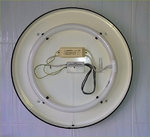Homebase circular bathroom mirror woes...
 Homebase Bathroom Mirror with circular fluorescent tubeI’ve a Homebase illuminated mirror in the bathroom, lit from inside by a circular 40W fluorescent tube. Unlike most fluorescent lamps, thanks to its electronic ballast this Homebase mirror lamp starts instantly with none of the annoying flashing associated with traditional lamps.
Homebase Bathroom Mirror with circular fluorescent tubeI’ve a Homebase illuminated mirror in the bathroom, lit from inside by a circular 40W fluorescent tube. Unlike most fluorescent lamps, thanks to its electronic ballast this Homebase mirror lamp starts instantly with none of the annoying flashing associated with traditional lamps.
I’ve learned quite a bit this week about these lighting fixtures, starting from the time when the thing suddenly refused to light up: on switching on it glowed feebly and then went out. It had to be the tube, or so I thought, so the search was on for a replacement fluorescent tube. I would eventually find that this mirror has a ‘reputation’.
Our kitchen uses the same size 40W circular lamp (with traditional-style starter). Recently that failed as well, and I had to hunt around for a replacement. This was hard going as none of the DIY sheds stocked any (Homebase was the safest bet, but were out of stock yet again), but a local lighting store supplied a new tube which was soon installed and running in the kitchen.
I noticed how the kitchen seemed ‘warmer’ and less stark than before, which was due to the different colour temperature of the new tube. I dug deeper into this aspect and that found these tubes have different colour specs. but it was entirely pot-luck which one your local store might have in stock: to them it’s just a 40W circular white fluorescent tube. So you could adopt either a brutal Xenon-like pallor or a healthier golden glow depending on what colour temperature the tube produced. Supermarket display cabinets mess around with fluorescent tubes a lot, in order to make butcher’s meat, for example, look a healthier shade of red.
Colour Temperatures
After measuring the mirror’s tube as 40cm across, I headed over to Wikipedia, where at http://en.wikipedia.org/wiki/Fluorescent_lamp_formats it’s mentioned that this unusual circular tube (Circline) is designated a ‘T9’ and has a four-pin connector called a G10q quadpin contact.
Colour temperatures are also spelled out: it’s stated this is a 3-digit code starting with 8 followed by 2 digits for the colour temperature, which is printed on the tube. As photographers will know, colour temperature is measured in °Kelvin with daylight being about 6,500°K. A higher colour temperature (eg 8,000°K) is a purer, starker white and a lower rating (say 3,000°K) is warmer and more golden-looking.
Hence the next two digits (830 or 865 for example) in the colour code refer to the colour temperature. Another factor called the Colour Rendering Index (CRI) describes how accurately the lamp reproduces colours across the board, as they can have spikes in the colour spectrum that gives strange results: that’s why my Honda is a very weird colour when seen at night under filling station lights.
 Sylvania 40W Circline tube - note the colour rating printed on the box (click to enlarge)
Sylvania 40W Circline tube - note the colour rating printed on the box (click to enlarge) The colour rating is also printed on the tube (click to enlarge)The most popular colours for a T9 Circular “Triphosphor” fluorescent tube are:
The colour rating is also printed on the tube (click to enlarge)The most popular colours for a T9 Circular “Triphosphor” fluorescent tube are:
830 – Warm white - e.g. kitchen, a slightly warmer glow
835 – White
840 – Cool white
865 – Daylight - bathroom mirror, a stark brilliant white
Then it’s onto ebay in search of some new tubes. Brands to look for include Crompton, Eveready and Sylvania. I wanted an 865 daylight tube for the mirror and (while I’m at it) a spare 830 for the kitchen light. The only supplier I could find on ebay wanted £16 carriage (ouch), and when I asked for a quote they simply said that I should pay the full amount and they’d refund whatever the difference would be. Not likely...
 Crompton 40W Circline tube with colour temperature arrowed (click to enlarge)
Crompton 40W Circline tube with colour temperature arrowed (click to enlarge)
The need for different colour temperatures became a bugbear, but eventually I found a supplier The Lightbulb Company www.thelightbulb.co.uk offering exactly what I needed. Suffice it to say the order was placed online on a Friday and they arrived safely first thing Monday morning.
And then the bad news!
The new fluorescent tube wouldn’t light either! So the problem had to be the electronic starter found in the Homebase mirror. Turns out quite a few people have had problems with the Landlite EB-56 electronic ballast failing. More of a problem has been trying to find a spare: there aren’t any, not even on the Hungarian manufacturer’s Landlite website http://www.bolt.landlite.hu/en/ where there is no such beast as a ballast for a circular fluorescent G10q with four pin plug.
In fact there were no electronic ballasts anywhere to be found at all. I guess they are a casualty of the move towards halogen and LED lighting. The last resort is a Chinese-made one for 40W circular fluorescent tubes listed on Amazon which (interestingly) several buyers have used for their Homebase mirror. They’re £6 each so I’ve bought two just in case.
See Part Two for full details of installing a new electronic ballast in this type of mirror. I also upgraded a Circline circular fluoresecent lamp in a similar way, details here.
More links
http://en.wikipedia.org/wiki/Kelvin#Colour_temperature
http://en.wikipedia.org/wiki/Fluorescent_lamp#Color_temperature
http://en.wikipedia.org/wiki/Color_rendering_index


 Tuesday, February 11, 2014 at 7:09PM
Tuesday, February 11, 2014 at 7:09PM